Table of Contents
At Go Fish Digital we work with a large number of eCommerce sites across a variety of different platforms. Since we started providing SEO services, we’ve had clients come to us on Commerce Cloud, WooCommerce, Magento, custom builds, and many more. However, there is one platform that’s stood out in recent years.
It’s no surprise that we’re seeing more and more websites utilizing Shopify and Shopify Plus. While it’s easy to point to the pandemic as the event that has triggered this “eCommerce renaissance”, the data shows that it’s been going on well before that. Looking at Shopify Plus usage statistics on BuiltWith, we can see that the platform has been gaining popularity since 2017.

While we’ve previously written about our best practices for general Shopify SEO, we wanted to write a more specific guide for Shopify Plus SEO. While the underlying technology is largely the same, we generally see different types of clients adopting the Shopify Plus platform. These are generally larger brands with bigger marketing teams.
What Is Shopify Plus SEO?
Shopify Plus SEO is a set of search engine optimization adjustments to Shopify Plus sites. Shopify Plus SEO initiatives include removing duplicate product page links, reducing JavaScript-dependent content, faceted navigation adjustments and more.
Related Content:
- Technical SEO Agency
- Ecommerce SEO Agency
- Shopify SEO Services
- Franchise SEO Agency
- Enterprise SEO Services
Shopify Plus sites tend to have larger inventories, more customization, and utilize more complex marketing technologies. With this in mind, we wanted to detail our best practices for when working with these types from an SEO perspective and the common issues a Shopify Plus store might encounter.
1. Duplicate Product Pages
One of the biggest SEO issues we find on Shopify Plus websites is the existence of duplicate content. Duplicate content occurs when the same content can be accessed at two or more unique URLs. Shopify Plus sites have a variety of ways in which they create duplicate content.
The first is duplicate product pages. Oftentimes, category pages on Shopify Plus will link to duplicate product pages.
For example, let’s take a look at the Untuckit website. We can notice that navigating to one of their product pages from a category page, we find the “Flannel Manning Shirt” (now discontinued). We can see that the URL has both /collections/ and /products/ in the URL path:
https://www.untuckit.com/collections/flannels/products/manning
![]()
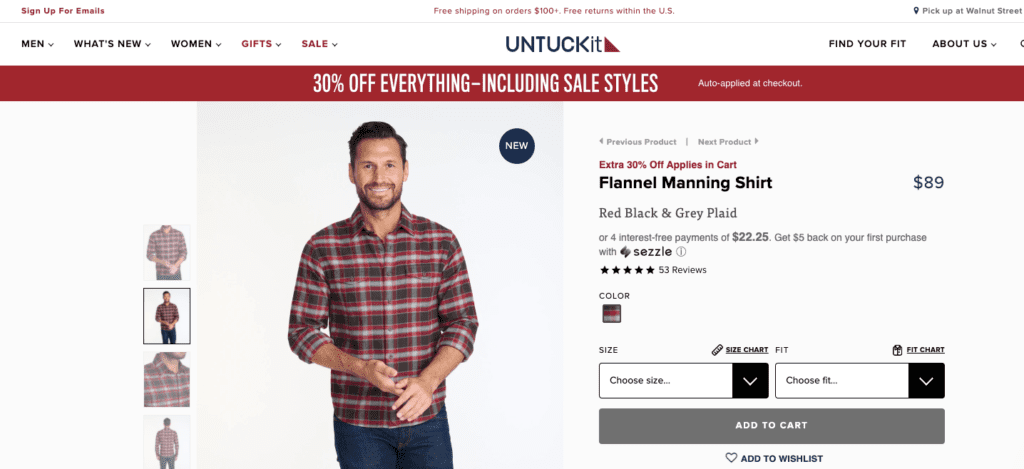
However, when we check the canonical tag of that particular page, we can see it points to another URL altogether. This URL only has /products/ the path: https://www.untuckit.com/products/manning

When we navigate to this page, we can see that it’s actually an exact duplicate of the URL listed above.
![]()

This creates an issue for Shopify Plus SEO. This means that the page that’s getting linked to from the category page is not the canonical URL. Instead, the category page is linking to a duplicate page that’s also capable of getting crawled/indexed.
As well, the larger issue is that this set up creates duplicate content at scale. Every single product linked to from category pages is a duplicate page. This means that Shopify Plus sites create a lot of potential duplicate content for important pages for SEO.
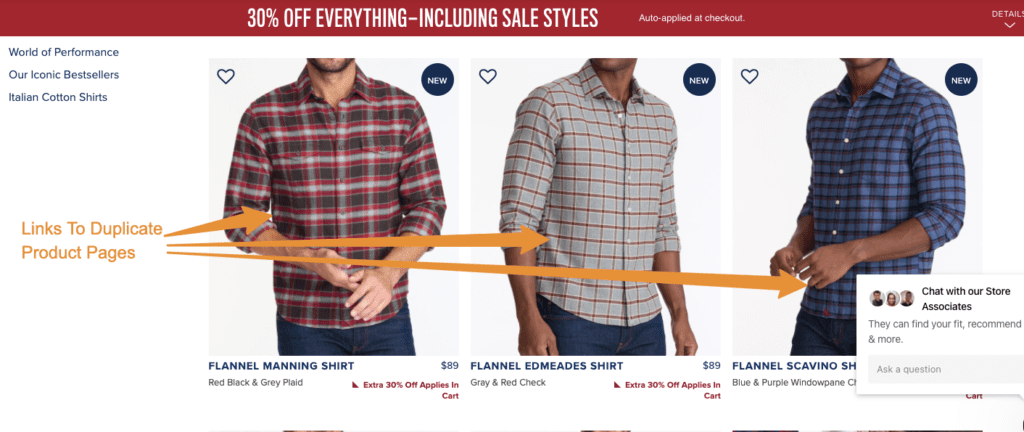
While the canonical tag is helpful to give Google consolidation signals for indexation, canonical tags are hints and not directives. This means that Google can ignore canonical tags and index the duplicate anyway.
Fortunately, there is a way to ensure that your Shopify Plus website’s category pages link to the correct product pages. By making an adjustment to the product-grid-item.liquid file, you can ensure that Shopify links to the correct product URLs on all of your site’s category pages. To learn more about how to fix this, you can read our guide on Shopify duplicate content.
2. JavaScript Rendered Content
Another major SEO consideration for Shopify Plus sites is JavaScript rendered content. Websites using Shopify Plus are more prone to having JavaScript crawling and indexing issues. This is because these stores generally carry larger inventories and are used by bigger brands. As a result, it’s more likely that developers have made adjustments or implemented JavaScript frameworks to deliver the content over the lifetime of the site.
While Google has gotten much better at crawling and indexing JavaScript over the years, this process still isn’t perfect. JavaScript SEO best practices still need to be followed for any site using the technology. If JavaScript hinders or outright hides content from getting crawled and indexed by Googlebot, this can have a deterrent effect on rankings.
For example, let’s take a look at Motherhood Maternity’s Nursing Bras category page. We can see that when we navigate to the URL, a standard category page is loaded. Here we can see the navigation, banner image, and product listings.

However, when turn off JavaScript, we see that the banner image and product listings are nowhere to be found:
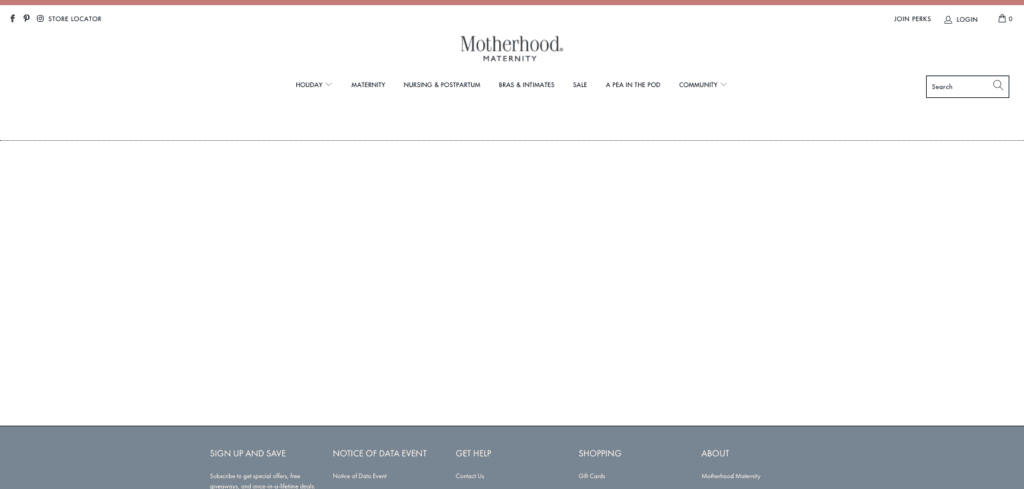
In order to further inspect this, we can use “View Source” to see the raw HTML of the page. This will show us the content of the page that’s accessible to search engines before any JavaScript is executed. When searching around for products such as the “Average Busted Seamless Maternity And Nursing Bra”, we can see that it cannot be found on the page:

This shows us that JavaScript is required in order to properly load key content of the page as isn’t accessible in the raw HTML. This is an indication that we’ll want to further review if Google is able to properly index our product listings.
When looking at Motherhood Maternity’s organic traffic, we can see that it has sharply declined over the past couple of years.
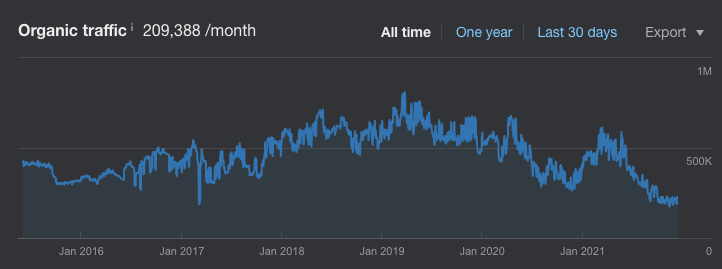
It’s possible that Google is having trouble indexing the JavaScript content which could be a source of the traffic drops. Since they use the FastSimon technology, they might want to test if pre-rendering the content helps improve organic rankings.
If your site is on Shopify Plus, you definitely want to be auditing your usage of JavaScript and testing to see if Google can properly index any JS rendered content. My colleague Pierce Brelinsky has written a fantastic JavaScript SEO guide that will help walk you through the process.
3. Faceted Navigation
Another major SEO consideration for Shopify Plus sites is faceted navigation. As Shopify Plus sites are likely to have larger inventories, they’re more likely to have implemented a faceted navigation. This functionality allows users to easily sort and filter category pages across different criteria (Size, Price, Material) to find the products most relevant to them. Faceted navigation can be great for users who are trying to browse through a large variety of products.
However, faceted navigations can cause significant SEO issues by creating a large amount of duplicate content. In many setups, every facet that’s selected creates a new URL. These URLs can quickly add up to a huge number of pages. In a case study from Google, they found that their store with 158 products created 380,000 URLs! URLs created by the faceted navigation are generally duplicate or similar to the source page as they only contain sorted and filtered views of the root category page. This can create large duplicate content issues.
Using an example, we can see that very thing on the Women’s Eyeglasses category page on Bonlook.
![]()
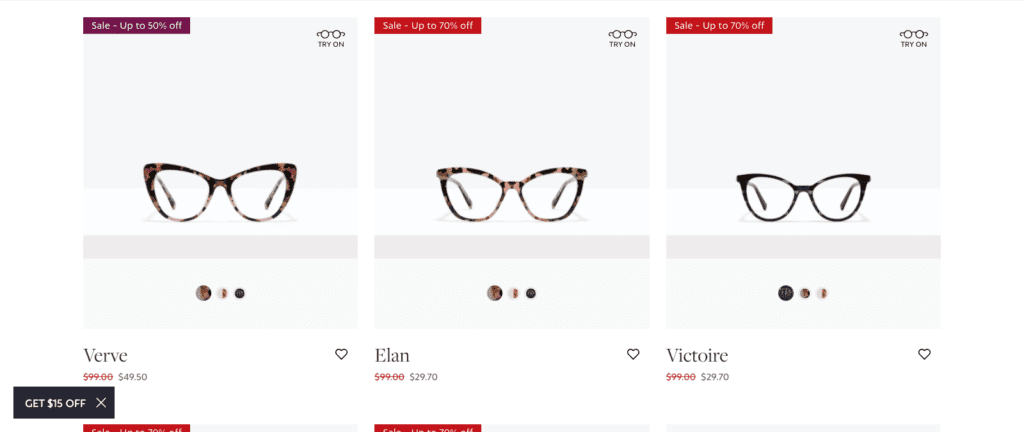
This category page contains a faceted navigation that allows users to filter by different parameters such as Size, Gender, Shape, and more:
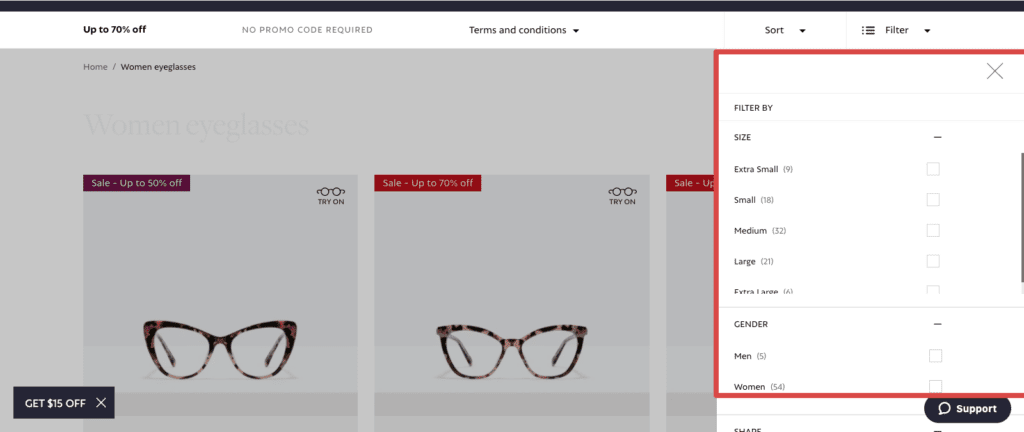
When selecting options from the faceted navigation, we can see that this changes the URL, creating a unique path for Google to crawl. When selecting the “Black”, “Female”, and “Cat Eye” options, we can see that this loads the following URL:
![]()

Notice how this content is very similar to the root category page. This could definitely be considered similar or duplicate content. If Google is able to index all of the parameterized pages created by the faceted navigation, this could lead to massive duplicate content issues.
Fortunately, this content is blocked by Shopify’s default rules in the robots.txt file. This prevents Google from crawling the many duplicate pages created by the faceted navigation.

However, if your Shopify Plus store uses faceted navigation, you’ll want to be sure to analyze if Google is able to crawl and index the large number of URLs that could be created. Oftentimes, we see that faceted navigations are not blocked by Shopify’s default robots.txt rules. This could lead to a large amount of crawl budget focused on low quality and duplicate pages.
4. Internal Site Search
Internal site search is another important part of Shopify Plus sites. As these sites have a large number of SKUs, it becomes critical for users to be able to use this functionality in order to quickly access the products they’re looking for on the store. If your store doesn’t have internal site search, we’d highly recommend adding it in a prominent location. Our data has shown that users who utilize internal site search can be much more likely to convert than users who don’t use it.
With internal site search, you need to be testing it to make sure that it’s not causing any SEO problems. The most common issue we find is that some Shopify stores can allow their internal search page to be crawled and potentially indexed. This could result in low quality pages in Google’s index that could impact the quality assessment of the rest of the site.
When looking at the Lord & Taylor website, we can see that they allow their internal search to be crawled. For instance, below we can see an internal search result page when looking for “Tote Bags.”

While this page is useful for users looking for Tote Bags, this is not a page that we would want to be crawled or indexed. Lord & Taylor already has created a Tote Bags category page that should be the primary ranking page for SEO.
However, when looking at their robots.txt file, we can see that Lord & Taylor does not block this page from being crawled by Googlebot:

As a result, Lord & Taylor might want to take steps to adjust their Shopify robots.txt file to block the crawling of their internal search pages. This will ensure that Google is not able to crawl through these low quality pages and potentially index them.
If you’re using internal site search, we recommend that you perform tests to ensure that Google cannot crawl your internal site search pages. If it can, we recommend creating rules in the Shopify robots.txt.liquid file to block Google from crawling them.
5. Structured Data
When working with any eCommerce site, structured data is an absolute must to consider. Structured data is a code that you can add to your website’s pages that makes it easier for search engines to understand the content of your page. Structured data can more directly tell search engines what the overall topic of a page is about as opposed to them having to interpret the content.
When working with Shopify Plus sites, we’ve found that many sites have inconsistent structured data. In most cases, elements such as the theme and Shopify apps automatically add structured data to the site. Unfortunately, most of the time we see that these technologies result in incorrect, incomplete, or duplicate structured data on the site.
For instance, here’s an example of a product page on Huel.com that doesn’t contain any structured data.

Overall, we recommend that Shopify Plus sites use the following structured data mappings. Please note that every page on your site should only have a single instance of each schema element:
- Home Page: Organization
- Category Pages: CollectionPage or OfferCatalog
- Product Pages: Product
- Blog Posts: Article
When it comes to implementation, you first need to check what structured data exists on each of your different page types. You can use tools like the Schema Validator to test this. You’ll then need to create a plan to ensure that the structured data mappings above get applied to each page type. This might involve working with a developer to remove some of the existing schema and then adding the proper mapped structured data.
If you don’t have developer resources, we highly recommend using Schema App Total Schema Markup to add schema to your Shopify site. This app does a fantastic job of implementing the mappings above and can also help you remove structured data added by the theme without the help of a developer.
For a deeper dive on Shopify Plus schema, you can read our Guide To Shopify Structured Data.
6. Site Speed
Performance is always something that’s top of mind for enterprise sites. Generally speaking, bigger brands that have larger marketing teams will have websites that end up getting slower over the long run. This is often because these sites are more prone to have different functionalities and technologies added to them over time. Analytics teams will add more tracking scripts and marketing teams request functionalities such as chatbots and animations. As a result, this can lead to slower performance on enterprise sites.

The good news for Shopify Plus sites is that the Shopify is already pretty fast out of the box. Recent data shows that the Shopify platform generally has some of the best Core Web Vitals of any other popular CMS (WordPress, Drupal, Wix, etc). This sets up Shopify store owners in a great position for site performance.
Of course, there are always initiatives that can be done to improve site performance. A study from Walmart discovered that every one second improvement in site performance can result in a +2% conversion rate for your site. For this reason, Shopify Plus sites need to keep performance top of mind.
From our years of working with Shopify sites, we’ve started to develop frameworks to help speed up Shopify stores. Below are some of the techniques and thought processes we use to help improve Shopify Plus performance:
- Audit Shopify apps and remove any unused or unnecessary ones.
- Implement lazy loading using the lasysizes.js library
- Ensure images are only uploaded at their display size
- Use Crush.pics to automatically compress Shopify images
- If starting a new store, find a lightweight Shopify theme
If you want more details on how to improve your store’s performance, you can read our Shopify Speed Optimization Guide.
Conclusion
While the SEO basics are the same between Shopify and Shopify Plus, the types of brands on Shopify Plus will most likely face more complex challenges. Larger inventories to manage, JavaScript frameworks, and increased technologies are all challenges that Shopify Plus stores are likely to face and store owners need to be aware of how these elements impact SEO. Hopefully this guide serves as a good starting point to helping improve your Shopify Plus store from an SEO perspective. If you have any questions about our Shopify Plus SEO services, please reach out to us!
Other Shopify SEO Resources
- Shopify Speed Optimization
- Improving Shopify Duplicate Content
- Shopify Sitemap.xml Guide
- Shopify Structured Data & Schema
- Shopify Robots.txt Guide
- Shopify SEO Tools
- All Shopify SEO Articles
Search News Straight To Your Inbox
*Required
Join thousands of marketers to get the best search news in under 5 minutes. Get resources, tips and more with The Splash newsletter: